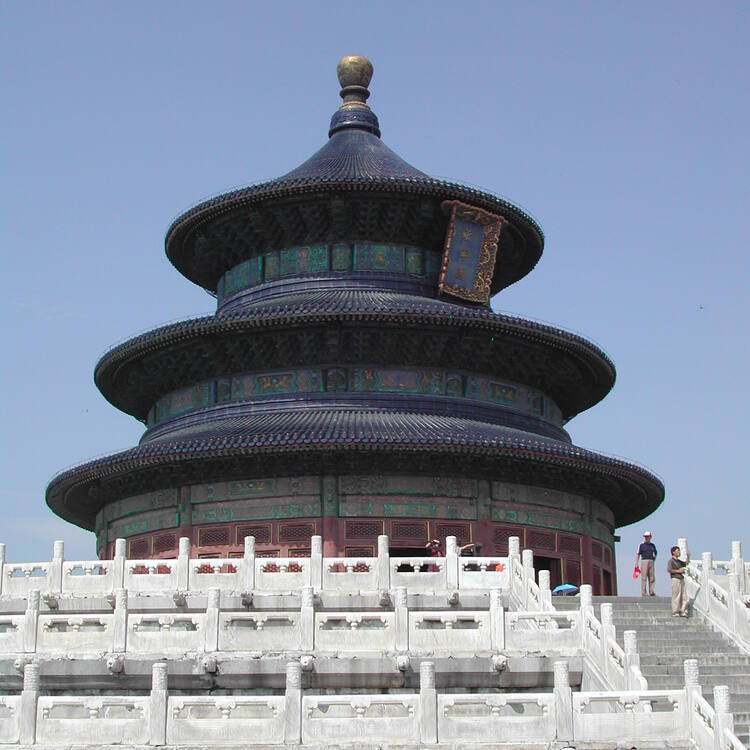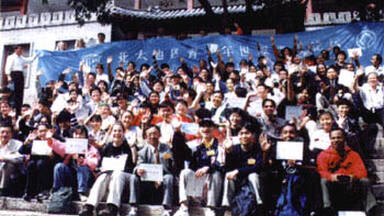Temple of Heaven: an Imperial Sacrificial Altar in Beijing
Temple of Heaven: an Imperial Sacrificial Altar in Beijing
The Temple of Heaven, founded in the first half of the 15th century, is a dignified complex of fine cult buildings set in gardens and surrounded by historic pine woods. In its overall layout and that of its individual buildings, it symbolizes the relationship between earth and heaven – the human world and God's world – which stands at the heart of Chinese cosmogony, and also the special role played by the emperors within that relationship.
Description is available under license CC-BY-SA IGO 3.0
Temple du Ciel, autel sacrificiel impérial à Beijing
Fondé dans la première moitié du XVe siècle, le temple du Ciel forme un ensemble majestueux de bâtiments dédiés au culte, situés dans des jardins et entourés de pinèdes historiques. Son agencement global, comme celui de chaque édifice, symbolise la relation entre le ciel et la terre – le monde humain et le monde divin – essence de la cosmogonie chinoise, ainsi que le rôle particulier des empereurs dans cette relation.
Description is available under license CC-BY-SA IGO 3.0
المعبد السماوي، المذبح الإمبراطوري في بيجينغ
تأسس المعبد السماوي في النصف الأوّل من القرن الخامس عشر وهو يُشكّلمجموعةً عظيمةً من المباني المكرّسة للعبادة والقائمة في حدائق تحيط بها غابات الصنوبر التاريخيّة. وفي ترتيبها الشامل كما في ترتيب كلٍّ منها ما يرمز إلى العلاقة بين السماء والأرض – عالم البشر وعالم الآلهة – وهي العلاقة القائمة في صلب علم نشأة الكون الصيني كما إلى دور الأباطرة المميز في هذه العلاقة.
source: UNESCO/CPE
Description is available under license CC-BY-SA IGO 3.0
北京皇家祭坛—天坛
天坛,建于15世纪上半叶,座落在皇家园林当中,四周古松环抱,是保存完好的坛庙建筑群。无论在整体布局还是单一建筑上,都反映出天地之间(即人神之间)的关系,而这一关系在中国古代宇宙观中占据着核心位置。同时,这些建筑还体现出帝王在这一关系中所起的独特作用。
source: UNESCO/CPE
Description is available under license CC-BY-SA IGO 3.0
Храм Неба: императорский жертвенный алтарь в Пекине
Храм Неба, основанный в первой половине XV в., - это величественный комплекс прекрасных культовых зданий, размещенный посреди садов и окруженный старинными сосновыми посадками. Своей общей планировкой и отдельными сооружениями он символизирует отношения между землей и небом – миром людей и миром Бога (эта идея находится в центре китайской космогонии), а также ту особую роль, которую в этих отношениях играют императоры.
source: UNESCO/CPE
Description is available under license CC-BY-SA IGO 3.0
Templo del Cielo, altar imperial de sacrificios en Beijing
Fundado en la primera mitad del siglo XV, el Templo del Cielo es un conjunto majestuoso de santuarios edificados entre jardines y rodeados de pinares centenarios. Su trazado general y el de cada uno de sus edificios simbolizan la relación entre cielo y tierra, esencia de la cosmogonía china, y la función especial desempeñada por los emperadores en esa relación.
source: UNESCO/CPE
Description is available under license CC-BY-SA IGO 3.0
天壇:北京の皇帝の廟壇
天壇は中国で冬至の日、即位の大典の直前や親征出発前などに、中国皇帝が天を祀る円形の丘壇。中国人の宇宙観にある天と地との関係や、その関係の中で皇帝の果たす特殊な役割の象徴である。古来首都の南方に設けられ、北京には1420年南方の外城に建造された。清の乾隆帝時代の1749年には拡張され、径を下壇約63m、中壇約45m、上壇約30mとした。1889年焼失したが、10年後に再興された。source: NFUAJ
Tempel van de hemel: een keizerlijk offeraltaar in Beijing
De tempel van de hemel (tian tan), werd gebouwd in de eerste helft van de 15e eeuw. Het is een complex van cultusgebouwen dat zuidelijk van de Verboden Stad ligt. Het geheel bevindt zich in een omgeving van tuinen en wordt omringd door dubbele muren en oude naaldbomen. De keizers van de Ming en de Qing dynastieën hielden hier plechtige, rituele ceremoniën, waarbij ze door te offeren aan de goden in ruil voor een goede oogst, als bemiddelaar tussen hemel en aarde functioneerden. In het westelijke deel bevindt zich de hal van de keizerlijke onthouding, waar de keizer vastte na het offerritueel.
Source: unesco.nl
Outstanding Universal Value
Brief synthesis
The Temple of Heaven is an axial arrangement of Circular Mound Altar to the south open to the sky with the conically roofed Imperial Vault of Heaven immediately to its north. This is linked by a raised sacred way to the circular, three-tiered, conically roofed Hall of Prayer for Good Harvests further to the north. Here at these places the emperors of the Ming and Qing dynasties as interlocutors between humankind and the celestial realm offered sacrifice to heaven and prayed for bumper harvests. To the west is the Hall of Abstinence where the emperor fasted after making sacrifice. The whole is surrounded by a double-walled, pine-treed enclosure. Between the inner and outer walls to the west are the Divine Music Administration hall and the building that was the Stables for Sacrificial Animals. Within the complex there are a total of 92 ancient buildings with 600 rooms. It is the most complete existing imperial sacrificial building complex in China and the world's largest existing building complex for offering sacrifice to heaven.
Located south of the Forbidden City on the east side of Yongnei Dajie, the original Altar of Heaven and Earth was completed together with the Forbidden City in 1420, the eighteenth year of the reign of the Ming Emperor Yongle. In the ninth year of the reign of Emperor Jiajing (1530) the decision was taken to offer separate sacrifices to heaven and earth, and so the Circular Mound Altar was built to the south of the main hall for sacrifices particularly to heaven. The Altar of Heaven and Earth was thereby renamed the Temple of Heaven in the thirteenth year of the reign of Emperor Jiajing (1534). The current arrangement of the Temple of Heaven complex covering 273ha was formed by 1749 after reconstruction by the Qing emperors Qianlong and Guangxu.
The siting, planning, and architectural design of the Temple of Heaven as well as the sacrificial ceremony and associated music were based on ancient tenets relating numbers and spatial organisation to beliefs about heaven and its relationship to people on earth, mediated by the emperor as the ‘Son of Heaven’. Other dynasties built altars for the worship of heaven but the Temple of Heaven in Beijing is a masterpiece of ancient Chinese culture and is the most representative work of numerous sacrificial buildings in China.
Criterion (i): The Temple of Heaven is a masterpiece of architecture and landscape design which simply and graphically illustrates a cosmogony of great importance for the evolution of one of the world’s great civilizations.
Criterion (ii): The symbolic layout and design of the Temple of Heaven had a profound influence on architecture and planning in the Far East over many centuries.
Criterion (iii): For more than two thousand years China was ruled by a series of feudal dynasties, the legitimacy of which is symbolized by the design and layout of the Temple of Heaven.
Integrity
The Temple of Heaven covers an area of 273ha and its ancient buildings are well preserved. The garden landscape and pathways have retained their historic layout. All elements necessary to express the value of the property are included within the boundaries of the property area. This ensures the integral representation of its uniqueness as a traditional Chinese cultural landscape.
Authenticity
The attributes such as the landscape layout and historic buildings are preserved either as built originally or as reconstructed in the Qing dynasty. The management and maintenance is carried out strictly in accordance with records in historical literature and archaeological evidence, to preserve the historic condition, while the exhibitions and displays are also designed to reflect the authenticity. The general layout and architectural features of the property vividly and distinctly demonstrate the traditional Chinese philosophical ideas, cosmogony, sacrificial rituals and scientific and artistic achievements,as well as genuinely reflect the political and cultural concepts and historic characteristics at that time.
Protection and management requirements
At the highest level the Temple of Heaven is protected by the Law of the People’s Republic of China on the Protection of Cultural Relics. In 1961, the Temple of Heaven was included by the State Council of the People’s Republic of China on the first group of State Priority Protected Sites. On the basis of efficient implementation of pertinent laws such as the Constitution of the People’s Republic of China, the Criminal Law of the People’s Republic of China, the Law of the People’s Republic of China on the Protection of Cultural Relics, the Law of the People’s Republic of China on Environmental Protection, and the Law of the People’s Republic of China on Urban Planning, relevant regulations on conservation and management have been formulated according to the practical situation. Any proposed measures or projects to be taken inside and outside the property area that may have any impact on the heritage values is prohibited without the approval of the national administration on cultural heritage. A buffer zone has been established.
At present, the main sacrificial building complexes including the Hall of Prayer for Good Harvests, the Circular Mound Altar, the Fasting Palace and the Divine Music Administration are all integrally preserved. The flourishing trees in the property remind people of the heyday of the site. The authenticity and integrity of the property are maintained and preserved by strictly observing pertinent principles and provisions of the Law of the People’s Republic of China on the Protection of Cultural Relics and through regular and rigorous maintenance and conservation projects. The management system of the Temple of Heaven has taken into account a wide range of measures provided under planning, heritage legislation and policies of the Central Government and Beijing Municipal Government. The Master Plan of Temple of Heaven on Protection and Management which provides the policy framework for the conservation and management of the Temple of Heaven is under formulation and will be presented to the World Heritage Committee as soon as it is complete.


